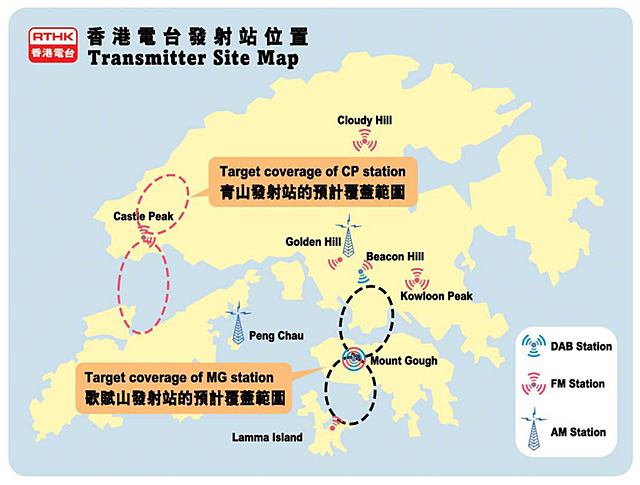| Digital Audio Broadcasting (DAB)
RTHK is currently conducting the phase four DAB trial,
which adopts Europe's Eureka 147 Band III system with the frequency 218.64MHz.
Two transmitters have been set up at Mount Gough and Castle Peak respectively,
covering areas of city center of Hong Kong, Kowloon and Tuen Mun, Tin
Shui Wai and Tung Chung.
The project is now underway and programmes of the FM and AM channels
are relayed with high-quality sound effect. To cope with the data transmission,
RTHK would set up trial points during the period of International Telecommunication
Union (ITU) Telecom World 2006 for the attendants and the public to experience
the high sound quality of this new technology.
Comparing with the existing broadcasting technology, DAB has the following
advantages:
- Using single frequency network enhances mobile reception and no fine-tune
of frequency is required;
- Rooted out the problem of interference in AM and FM broadcast;
- Provides crystal clear sound that is comparable to near CD quality
or even to the surround sound effect;
- Data transmission alongside with audio broadcast providing text-based
information such as instant reports on finance, weather and traffic
news etc;
- More channels will be available in the same frequency spectrum as
compare with AM and FM transmissions. Each 1.5MHz frequency spectrum
of DAB can transmit six sets of programmes with CD quality.
In conclusion, DAB provides multimedia broadcasting environment that
enables the media to develop a new market, and offers the audience better
broadcast quality and service.
Technical information:
Frequency |
218.64MHz |
Bandwidth |
1.536MHz |
Radiated power |
Mount Gough 600W / Castle Peak 110W |
Audio data rate |
160 / 192 kbps |
Modulation method |
Coded Orthogonal Frequency
Division Multiplex |
International standard |
ETS 300 401 |
Website |
http://www.worlddab.org/ |
Points to note:
- Since it is a trial, signals may be interrupted temporarily without
prior notice.
- The receiver selects channels automatically. When reception is in
normal condition, display screen of the receiver will show the name
of the channel: RTHK R5 IN DAB, RTHK PTC IN DAB and so on.
- You are invited to express your comments through our
website at www.rthk.org.hk/about/digitalbroadcasting/.
Thank you.

issue: November 27, 2006
�@�@Digital
Sound Broadcasting (DSB) offers a robust form of transmission
in the broadcasting industry, using digital compression technology to
deliver audio, text, pictures and data by reducing transmission bandwidth
requirements, as well as storage requirements and provides digital quality
and reliability.
The DSB system serves an area by using one single frequency (Single Frequency
Network). This significantly expands the number of channels available
and allows for a more efficient use of the available spectrum as well
as more interaction with audience members.
DSB has the potential to offer consumers territory-wide high-quality transmission
of all existing radio stations plus dozens of new ones without distortion
and interference. DSB offers the industry including public broadcasters
a means of providing more choice.
RTHK, together with the Information Technology and Broadcasting Bureau,
Hong Kong Commercial Radio & Metro Broadcast Corporation, ran tests
on digital signals in 1998 on L-Band �V originally from two transmitter
sites �V Mount Gough and Beacon Hill. With the digitization of broadcasting
platforms, the path to enhanced broadcast services has been laid.
In 2004, RTHK intends to commence tests on digital broadcasting in two
phases. In March, test on Digital Radio Mondiale (DRM), the digital system
for medium-wave and AM, has been held. Another test on Eureka 147 DAB
Band III is commenced in September. During the trial, programmes of AM
and FM stations will be relayed. From April to May, 2005, RTHK has set
up trial points at different locations for the public to experience the
high sound quality of this new technology.
As the public broadcaster, RTHK should continue to catch the wave of the
booming tech industry and research into the possibility of introducing
more platforms so that broadcasters can explore the enhancement of the
quality and range of the public service provision.
|